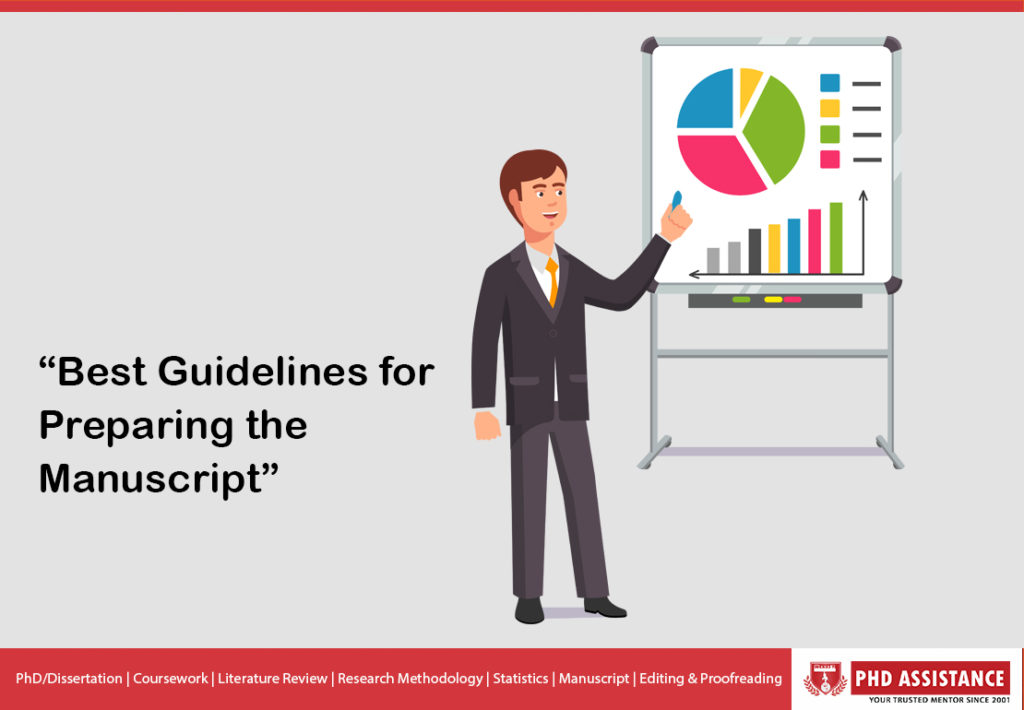Best Guidelines for Preparing the Manuscript
If you are finding difficult in preparing the manuscript document. You can hire our Phd guidance support you in preparing the manuscript and happy to advise you. List of the below guidelines will help ensure a high-quality and finite publication process.

A manuscript consists of the following includes:
1. Front Pages- Title page, Table of contents, Introduction, (acknowledgments, dedication, preface-If applicable).
2. Chapter sections (Include Figures and interpretation Presented Tables).
3. Notes, bibliographies, and/or reference lists.
Structure of a Manuscript
During Manuscript preparation, Please do follow these basic guidelines
The manuscript needs to be structured as follows:
1.Front Matter:It includes article title, author names and their affiliations, article note, abstract, keywords and abbreviations. Please supply all emails, telephone numbers and address of each author and editor. It is necessary to ensure that the course of the author names are correct and the title of your book. Article note can be useful to point out features of the article. Abstract can be given within 250 words. Keywords might be useful for finding important words (3 to 6). You can also used the list of abbreviations and/or symbols(optional)
2.Body Matter:
It encompasses the chapters containing the content or journal, (text, figures, and tables).
1. Content
It is an essential factor to use either British or American English while writing your book but be consistent within your chapter or book. It is important to use the major word-processing program preferably Microsoft word (Do not Submit PDF format). Please Do follow the Simple formatting It is most preferable to use Times New Roman(Font family),12-point(Font size), double line spacing(font-spacing) and 1.5 inch margins.Do not use more than 3 subheadings
2. Table
Titles should identify the table as briefly as possible. In an article that contains more than one table, each title should be unique. Only horizontal lines are allowed; no vertical lines, boxes, or other lines may be used unless they indicate the structure of the data.
3. Figures
Your artwork will be cropped and sized for publication. If you want to be certain that a particular area of your image is excluded or included, please indicate where the image should be cropped. If the artwork you are transmitting has been published elsewhere or is otherwise copyrighted, the Press must have a letter of permission from the copyright holder in order to use the image. Eliminate the use of placing labels over Figure’s shaded areas and also avoid gray or color in bar graphs instead use solid black, solid white, and patterned.
Please use the callouts inside the paragraph to show the approximate figure’s location. For example: “see figure 1.1”. Place the figure no and caption at the end of the chapter
Include the figure number and figure caption at the end of the chapter.
4. Equations
If you are likely to include Mathematical equation then we strongly recommend to use Mathtype (tool), it is a premium software used only 30-days free trial. Other popular tools less robust even though it is freely available. They are two types:Display and Inline equations.
3. Back Matter:It can have acknowledgements, author contributions, funding informations, conflict of interest, ethical approval, informed consent, human participants, appendix or electronic supplementary materials (ESM) for online and references. Two types of references are there; numbered and name and year. For numbered reference, citation must be sequential or in alphabetical order in reference list. For name and year, must be ordered alphabetically with year in parentheses
4. Author Responsibilities: To ensure successful publication, you must meet all deadlines provided to you by your editor. A manuscript consists of the following elements; The text must be in one of the major word-processing programs, preferably Microsoft Word. Do not submit PDFs of your text; send only word-processing files.



